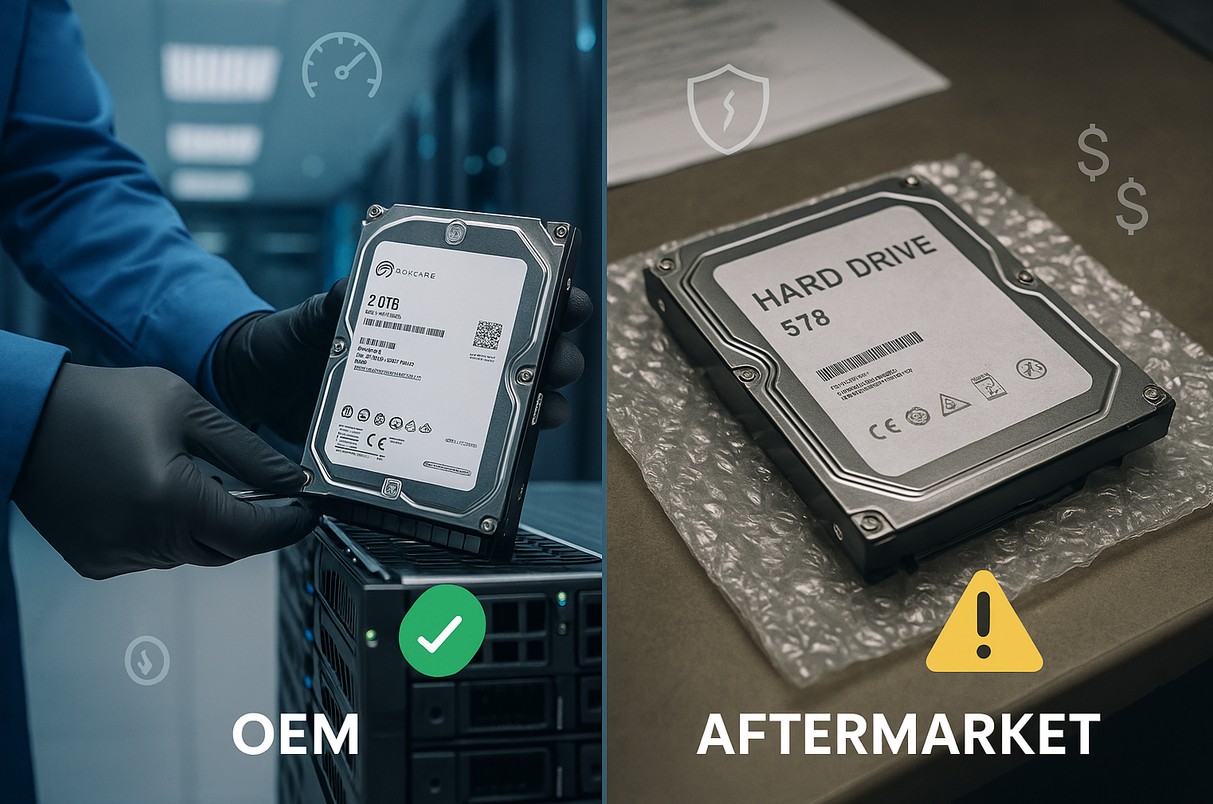Choosing between OEM and aftermarket parts is a strategic decision that impacts hardware performance, cost, warranty, and risk. This article compares the two options in the context of IT hardware management, helping organizations make informed choices. Selecting the right components ensures not only operational continuity but also long-term cost efficiency and asset longevity.
Understanding OEM and Aftermarket Parts
IT professionals must fully grasp the distinctions between OEM and aftermarket parts to manage system integrity and minimize performance issues. The definitions outlined below set the stage for effective procurement and risk assessment. Misunderstanding these categories can result in compatibility problems, voided warranties, or reduced system uptime. A clear understanding enables IT leaders to craft procurement strategies that align with operational goals.
What Are OEM Parts?
OEM parts are manufactured by the original producer of a system’s components. These parts preserve original system architecture and help meet strict compliance requirements, particularly in industries with regulated standards such as healthcare, finance, and aviation. They are subject to rigorous quality control processes and are engineered to integrate seamlessly with associated hardware and software platforms. Additionally, OEM components often come with embedded security features and proprietary firmware updates that third-party parts may lack.
- OEM parts are made by the system’s original equipment manufacturer (OEM)
- They are engineered for exact compatibility and reliability
- Often include manufacturer-backed warranties and technical support
What Are Aftermarket Parts?
Aftermarket parts are manufactured by companies other than the original equipment producer, often to similar specifications. They are commonly used in cost-sensitive applications where performance tolerances allow for greater flexibility in specifications and brand selection. While some aftermarket manufacturers maintain strict quality standards, others may compromise on quality to reduce costs, leading to wide variability in performance and reliability. The lack of formal certification can introduce integration or security risks, particularly in regulated environments.
- Aftermarket parts are manufactured by third-party vendors
- They provide a cost-effective alternative to OEM components
- Quality, compatibility, and security assurances can vary
Advantages of OEM Parts for IT Hardware Reliability
For enterprises prioritizing reliability, OEM parts offer a consistent experience backed by trusted engineering standards and detailed documentation for each product line. These components are designed with the system’s full lifecycle in mind, often allowing for extended OEM support and guaranteed upgrade compatibility. In environments that require consistent uptime, such as hospitals, financial institutions, and data centers, OEM parts provide critical assurance and operational stability.
To summarize, OEM parts offer:
- Undergo rigorous quality assurance and Underwriters Laboratories (UL) testing
- Designed for full compatibility with OEM-certified systems
- Preserve warranty coverage and manufacturer support
Disadvantages of OEM Parts in IT Procurement
Despite their quality, the higher cost and limited sourcing options make OEM parts less suitable for organizations focused on cost optimization or rapid deployments. OEM supply chains can also face delays, particularly during global shortages or geopolitical disruptions. In addition, OEM-only policies may reduce vendor flexibility, leading to longer procurement cycles and less agility during hardware refresh initiatives.
Common disadvantages of OEM parts include:
- Higher costs compared to third-party components.
- Limited availability due to vendor lock-in or supply chain delays.
Advantages of Aftermarket Parts in IT Lifecycle Management
Organizations with decentralized IT operations or constrained budgets often turn to aftermarket parts to maintain operations while preserving responsiveness. These components are generally more readily available from a broader range of vendors, enabling businesses to stock inventory and respond swiftly to urgent maintenance needs. For non-critical systems or temporary setups, aftermarket solutions can offer a strategic choice.
To summarize, aftermarket parts offer:
- Lower price point—up to 70% cheaper than OEM parts
Some sources claim that third-party maintenance (TPM) can reduce hardware support costs by 40–70%. - More accessible during global supply chain disruptions
- Offer flexibility and customization options for unique use cases
Disadvantages of Aftermarket Parts: Risk vs. Reward
Enterprises must weigh these limitations carefully, especially in high-volume or regulated environments where even slight incompatibilities can result in cascading failures. Procuring unverified aftermarket parts increases the risk of counterfeit or low-quality components that may damage the IT infrastructure. The lack of traceability and performance guarantees can also complicate compliance, particularly in audit-prone industries.
Common disadvantages of aftermarket parts include:
- May cause compatibility issues with existing firmware or systems
- Often lack formal quality assurance certifications
- Use may void OEM warranties and service agreements
Strategic Considerations for IT Hardware Performance
A strategic procurement plan must account for operational priorities, resource constraints, and the evolving technology landscape. The choice between OEM and aftermarket parts should reflect a clear understanding of hardware criticality, acceptable downtime, and long-term return on investment (ROI). Forward-thinking organizations evaluate failure rates, vendor reliability, and component longevity when designing hardware lifecycle strategies. Establishing robust evaluation criteria enables IT leaders to justify purchasing decisions across finance, operations, and compliance teams.
Consider the following:
- Evaluate total cost of ownership, not just upfront cost
- OEM components support longer hardware lifecycles
- Hybrid sourcing strategies can balance cost with critical performance needs
- Factor in vendor reputation and risk of unplanned downtime
According to CIO Magazine, during the COVID-19 pandemic, 40% of IT budgets remained flat and 39% decreased, highlighting the pressure to optimize IT support and procurement costs.
The Role of Authentication Technologies in Supply Chain Security
Authentication tools are essential for deterring counterfeit parts and ensuring traceability in global supply chains, particularly where part origin and compliance validation are non-negotiable. In industries like defense, healthcare, and government, these technologies play a critical role in risk management. OEMSource uses methods such as serialization, tamper-evident packaging, and blockchain-backed chain-of-custody systems to verify every component’s authenticity and provenance.
Authentication tools:
- Prevent counterfeit components from compromising infrastructure
- Include serialization, QR codes, and tamper-evident packaging
- Enable OEMSource to guarantee traceability and certification with each shipment
Best Practices for Implementation and Lifecycle Performance
Following structured procurement and installation procedures and partnering with a trusted lifecycle management provider can reduce operational risk and improve IT system performance. Establishing clear policies for vendor selection, component testing, and replacement documentation ensures transparency and audit readiness. Whether integrating OEM or aftermarket components, a disciplined approach helps protect infrastructure and extend asset lifespan.
Balance, Verification, and Lifecycle Alignment
The choice between OEM and aftermarket IT hardware parts isn’t always binary it’s about aligning part selection with performance demands, risk tolerance, and total cost of ownership. By establishing evaluation frameworks, leveraging authentication tools, and working with trusted lifecycle partners, organizations can reduce risk, extend asset life, and protect critical infrastructure.
OEMSource helps enterprises navigate these decisions with confidence, offering verified components, transparent documentation, and full lifecycle support tailored to your infrastructure and compliance needs.
Frequently Asked Questions
What are the advantages of OEM parts?
OEM parts ensure compatibility, preserve warranty coverage, and deliver consistent quality, critical for enterprise-grade performance. They’re engineered to the manufacturer’s original specifications and validated through testing protocols that many third-party components may not undergo.
What is the role of original equipment manufacturers (OEMs) in hardware security?
OEMs embed proprietary firmware and authentication measures to protect systems, reduce vulnerabilities, and support compliance in regulated environments. Their control over part design, firmware updates, and integration standards makes them foundational to supply chain trust
Why are OEM parts considered more reliable?
They provide predictable performance, full platform compatibility, and manufacturer-backed support, especially important in mission-critical environments. OEM components also come with detailed documentation, compliance certifications, and lifecycle management options that help optimize long-term value.
What is OEM in information technology?
In IT, OEM refers to manufacturers that produce hardware or software integrated into another company’s product. OEM components match original specs, often include firmware integration, and are recognized by system BIOS and diagnostic tools, ensuring seamless compatibility and system performance.
When should I choose OEM parts over aftermarket alternatives?
Choose OEM parts when system uptime, security, and compliance are top priorities—especially in industries like healthcare, finance, or government. OEM components are ideal for critical infrastructure, warranty-sensitive equipment, and environments that demand certified traceability and long-term reliability.





